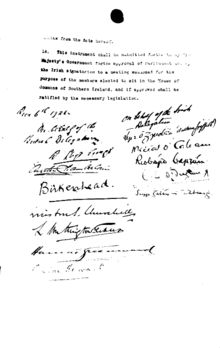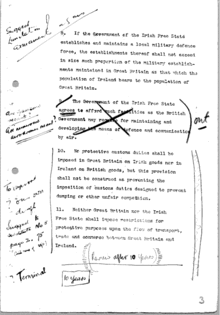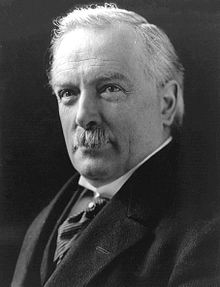Anglo-Irish Treaty
The Anglo-Irish Treaty ( Irish Conradh Angla-Éireannach , English Anglo-Irish Treaty , also The Treaty or Articles of Agreement ) from 1921 between the British government and emissaries of the republican leadership in Ireland ended the Irish War of Independence and sealed the creation of the Irish Free State. With the ratification five sixths of Ireland - the Irish Free State - became a separate area of dominion within the British Empire , while the other six counties remained under the name Northern Ireland with the United Kingdom . The contract was signed on December 6, 1921 in London by representatives of the British Government and Plenipotentiaries of the Irish Republic. The ratification of this treaty was the main reason for the start of the Irish civil war .
Content of the contract
The main points of the contract were:
- British forces are being withdrawn from almost all of Ireland.
- Ireland becomes a sovereign territory with independent government within the British Empire, like Canada , Newfoundland , Australia , New Zealand and South Africa .
- As with the other rulers, the formal head of state of the Irish Free State would be the British ruler, represented by a representative of the crown.
- Members of the new parliament have to take an oath of allegiance to the Free State. A second part of the oath concerns loyalty to "King George V , his heirs and successors".
- Northern Ireland (which was already formed by the Home Rule (1920) - also the Government of Ireland Act 1920 - has the opportunity to leave the Free State within one month.
- If Northern Ireland were to leave (which it did), a Boundary Commission would be created to determine the border between the Free State and Northern Ireland.
- Britain retains control of some ports in Ireland (known as the Treaty Ports ) for its own protection .
- The Free State is responsible for its part of the liabilities towards the Crown.
- The treaty stands over the newly created constitution of the Irish Free State .
Negotiator
Among the negotiators were:
British delegation
- David Lloyd George , Prime Minister
- Lord Birkenhead , Lord Chancellor
- Winston Churchill , Secretary of State for the Colonies
- Austen Chamberlain , Keeper of the Lord Seal
- Gordon Hewart , Attorney General for England and Wales
Irish delegation
- Arthur Griffith , chairman
- Michael Collins , Treasury Secretary of the Republic of Ireland and Head of the Irish Republican Brotherhood
- Robert Childers Barton , Secretary of Commerce
- Eamonn Duggan , Teachta Dála
- George Gavan Duffy , Teachta Dála
Robert Erskine Childers , author of The Riddle of the Sandbar and former member of the House of Commons, acted as a secretary to the Irish delegation.
consequences
The content of the treaty divided the Irish Republican leadership and resulted in the President of the Irish Republic Éamon de Valera leading the minority of opponents. The main point of contention of the treaty was the lack of independence of the republic (characterized by the oath of allegiance to the English crown). The division of the island was also a point of contention, but not the most important; Both sides assumed that the Boundary Commission would award large parts of the split-off counties to the Free State, making Northern Ireland too small to be able to exist as an independent political unit alongside Irish unity for a long time. In fact, the Commission did not change the borders.
The Second Dáil (second elected Irish Parliament) ratified the treaty formally in December 1921. The House of Commons of Southern Ireland ( lower house of Southern Ireland ), which consisted of the same people almost, but was Parliament from the perspective of the British, the the Treaty in the first place had to agree, ratified it in January 1922. De Valera then resigned as president. He was succeeded by Arthur Griffith . As stated in the treaty, Michael Collins established a Provisional Government of Ireland under the House of Commons of Southern Ireland. In December 1922, the Third Dáil passed the new Irish Constitution into law.
Opponents of the treaty, above all Éamon de Valera, launched a campaign against the entry into force during this process, which led to the Irish civil war . In 1922, two of the main signatories died: President Griffith died of heart failure; Michael Collins was murdered in August. When signing the contract, Collins already suspected that he was signing his death warrant in addition to the contract. William T. Cosgrave was the successor to both men.
The reference in the treaty to the monarchy, the authority of command and the superior legal status of the treaty was only deleted from the Irish constitution in 1932 due to the statute of Westminster . Less than ten years earlier, Michael Collins had argued that the treaty would "give the freedom to achieve freedom in Ireland " .
Although the British government has had Home Rule since 1914 . H. had sought autonomous self-government for the entire island of Ireland , the British Parliament believed that complete independence of Ireland in 1921 would have led to a massacre of Catholics in Ulster by their heavily armed Protestant "neighbors". Although unionists lived across the country, they were very much concentrated in the northeast. An uprising by them against the “Home Rule” would have been tantamount to a revolt against the “mother country”, and thus quasi a civil war. Dominion status for 26, with the secession of the remaining six counties, seemed the best way forward at the time.
In fact, the status of Dominion , which Canada, New Zealand and Australia also received, was far more than the concessions of the first "Home Rule" treaty from 1914 and certainly more extensive than the "Home Rule" that was made in the 19th century Charles Stewart Parnell had been offered.
The concessions are even more remarkable when you look at the state of the Irish Republican Army (IRA) at the time of the armistice. The IRA was running out of weapons and ammunition. When Collins first learned of the proposed armistice in mid-1921 (see also Irish War of Independence ) , he thought the British were insane. The British, while never getting the idea, were only weeks or days away from smashing the IRA.
Éamon de Valera was once asked what his greatest mistake was. He replied: "Not to accept the contract".
See also
Other contracts between Great Britain and Ireland:
- Treaty of Limerick (1691)
- Sunningdale Agreement (1973)
- Anglo-Irish Agreement (1985)
- Good Friday Agreement (1998)
- St Andrews Agreement (2006)
literature
- Tim Pat Coogan: Michael Collins. a biography . Hutchinson, London 1990, ISBN 0-09-174106-8 .
- Tim Pat Coogan: DeValera. long fel . low, long shadow . Hutchinson, London 1993, ISBN 0-09-175030-X .
- John Joseph Lee: Ireland 1912–1985. Politics and Society . Cambridge University Press, Cambridge 1989, ISBN 0-521-26648-3 .
Web links
- complete text of the Anglo-Irish Agreement (English)
- Record of the debate on the Treaty (English)
This text is based on a translation of the article Anglo-Irish Treaty from the English Wikipedia, version of July 9, 2005.



